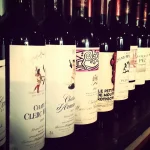Marketing specialists often tell us about the power of FOMO (Fear of Missing Out) but that worry has an equally potent brother – FOBRO (Fear of Being Ripped Off).
Wine is certainly afflicted by this second fear yet, while a few wines are indeed overpriced, expensive wines so often cost more for valid reasons.
For one, getting the best of everything they often need – land, fruit, terroir and winemaking skills – usually makes costs high.
Inside the bottle expensive wines often have greater complexity, better balance and often longevity (both in the cellar and after the bottle is opened).
Taking just that last point, a bottle of inexpensive short-life wine will usually have deteriorated 24 hours after it’s opened while superior versions will have held (and even enhanced) their enjoyability.
So, an occasional treat of more expensive wine is certainly something to relish as, I hope, is March’s “Sunday Best” post (below) about those “special occasion” wines.
Once again, pictures and hyperlinks are there to help you find more details about the wine.
Starting with a Spanish favourite
Spain’s Rias Baixas region does a pretty good job of keeping albarino prices sensible but – as we see here – slightly more expensive versions can often add an extra dimension of flavour and depth.
Delightfully textured and with creamy depth, 2019 Albarino De Fefinane (£15.99 list price at Waitrose but see the Stop Press about multi-buys – and 13.5% abv) has pear, apple and quince flavours supported by well-judged zesty acidity and a vaguely saline finish. Stocks are running low though.
Getting back nearer home
Three Choirs provide The Wine Society’s “house” English wine and the latest (2020) vintage – that should be available from this week – is an excellent illustration of how alluring English still wine (as well as its fizz) can be.
With aromas of roses, 2020 The Society’s English White (£8.50 at The Wine Society and 11%) follows up with textured red apple, pear and fresh pineapple flavours supported by sharp grapefruit acidity and hints of allspice and aniseed.,
Sweetening things up slightly
With the emphasis on drier styles of riesling, it is easy to overlook how good off-dry ones can be as demonstrated by this American version from the state that – slightly surprisingly – contains the world’s largest riesling producer (Ste Michelle Wine Estates).
Unmistakably off-dry yet delightfully fresh and clean tasting, Washington State’s 2019 Eight Thousand Lakes Riesling (from £9.99 at Majestic and 11.5%) provides soft apple, melon and ripe pear flavours with modest lime acidity and suggestions of green herbs.
Moving on to sparkling fare
True to conventional wisdom, this Asolo prosecco feels weightier than DOCG versions from Conegliano-Valdobbiadene and neatly points up how examples from that tiny area leave room for (and take advantage of) secondary flavours beyond its main fruit components.
With small somewhat languid bubbles but a fresh mouthfeel, The Emissary Asolo Prosecco (£17.99 at www.theemissary.co.uk/shop and 11%) is centred on restrained apple, quince and orange flavours and supports them with pithy citrus acidity and soft, savoury (saline tinged) depth.
And bubbles from France
With so many geographically spread parts of France entitled to produce sparkling wine and call it cremant, it is not surprising that styles (and, alas, sometimes quality) varies but this one from Languedoc is a nicely crafted version with bags of all round appeal – although the price when not discounted does seem on the top edge.
Pale, perfumed and floral, Languedoc’s 2018 Finest Cremant de Limoux Rosé (£12 at Tesco and 12.5%) has raspberry, crab apple and red cherry flavours with sharp and lively tangerine acidity, hints of spice and sweet edges but complementary rhubarb-style dryness too.
On to the reds
While whites like the brilliant assyrtiko have helped establish Greece’s credentials as a wine producing country, it has impressive reds too like this one made in a region close to the country’s northern border from a grape (Xinomavro) with aromas Jancis Robinson likens to Barolo.
Bright and medium bodied yet mineral edged, 2018 Thymiopolous Xinomavro (from £11.99 at Majestic and 13%) has vivid raspberry and mulberry fruit, bold acidity, balanced tannin with underlying suggestions of charcoal, ginger snap and cinnamon.
Something a little more familiar
As Chris Losh’s excellent piece in Just Drinks spells out, South Africa’s wine industry is really under the cosh for reasons beyond Covid (although that hasn’t helped) and our sadness about that is re-doubled when we see just how good their wines (like this one) can be.
Soft and beautifully balanced, 2018 Kanonkop Kadette Cape Blend (£13.35 at Frontier Wines and 14%) employs a fusion of pinotage with Bordeaux blend grapes to offer us dark loganberry, cherry and prune flavours embellished with lively acidity, firm tannin graphite style complexity and concluding clove and mocha influences.
Speaking of Blends
As well as those Bordeaux blends, France also has the world-famous GSM blends from the Southern Rhone.
Here is one – well almost – since this guy (from Rasteau north east of Chateauneuf du Pape and Orange) actually just contains syrah and grenache since mourvèdre does not always ripen enough too far north.
Dark and slightly smoky, 2017 Rasteau ‘L’Andéol’ Famile Perrin (from £14.99 at Majestic and 13.5%) delivers medium bodied, sour cherry and elderberry flavours combined with firm acidy, modest tannin, graphite savouriness and concluding clove, bitter almond and milk chocolate components.
How’s this for lateral thinking?
Here is a brilliantly imaginative idea (from the family that has done more than most to further apassimento techniques in Italy) which re-ferments malbec from Argentina’s Uco Valley with dried corvina (the Amarone grape) to create spectacular results.
Inky but aromatic the organic 2018 Masi Tupungato Passo Doble Organic Wine (£13.25 at Fareham Wine Cellar and 14%) delivers herbal plum and cherry flavours accompanied by limited tannin yet vibrant acidity with cinnamon, chocolate and liquorice touches and that sense of ripeness and sweetness that the technique amply provides.
Traditional and reassuringly expensive
Let’s end on a high spot with another example of how superb the wines of South Australia’s Taylor family can be – they are sold in the UK under the Wakefield name to avoid confusion with the port shipper.
This guy won the Treat Yourself red wine category in the People’s Choice Drinks Awards alongside its cabernet sauvignon sibling that triumphed in the Food Friendly – Red class.
Intense and delightfully aromatic, 2018 Wakefield St Andrews Shiraz (the 2018 is only just arriving but the similarly impressive 2016 vintage costs £33.59 at Sandhams Wine Merchants – and 14.5%). The 2018 brings us complex blackberry, damson and cherry flavours with nippy acidity, soft tannin, and touches of nuts, caramel, liquorice and cinnamon.
Do drop by again on Monday when we unveil the latest Top Tips and catch up with the major retailers’ current promotions.
STOP PRESS
As alluded to in the main post, Waitrose currently have a deal offering 25% off all wine and Champagne priced £5 and over, when purchasing any six or more bottles.
It started yesterday and runs to 9 March but, as usual, does not apply to branches in Scotland, Wales or Jersey, motorway service stations, Welcome Break, petrol stations or via Deliveroo.
More about this on Monday


















